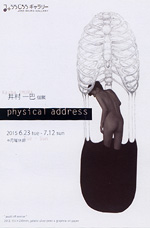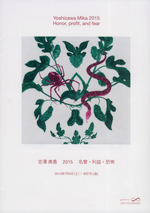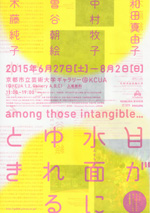 |
Picks is a monthly sampling of Japan's art scene, offering commentary by a variety of reviewers about exhibitions at museums and galleries in recent weeks, with an emphasis on contemporary art by young artists. |
 |
 |
 |
1 September 2015 |
 |
| 1 | 2 | |
 |
|
 |
 |
|
|
 |
|
| Issei Suda: SOLO |
| 27 June - 18 July 2015 |
Gallery Naruyama
(Tokyo) |
 |
| Veteran photographer Suda (b. 1940) introduces 16 new works shot in 2014. One senses an aperture cracking open a bit in Suda's oeuvre, which has always been relentlessly monochromatic. Since the outset his work has betrayed an obsession with denizens of a surreal world outside the "real" one; if anything, that inclination has grown more pronounced. |
|
|
 |
 |
|
| Kazha Imura: Physical Address |
| 23 June - 12 July 2015 |
Jiro Miura Gallery
(Tokyo) |
 |
| Imura creates her works by the unusual technique of pin-scratching, using a safety pin to inscribe intricate patterns on the surface of monochrome prints. Most of the original photographs are nude self-portraits in which the contours of her body emerge from pitch-blackness. The delicate intermingling of shadows and scratches yields images of a tiny yet profound microcosm. |
|
|

|
 |
 |
 |
 |
| Unknown VOID Series No. 6: Mineki Murata |
| 26 June - 12 July 2015 |
void+
(Tokyo) |
 |
| Performance artist Murata has scratched his way through a number of mediums -- paper, dictionaries, plywood, LCD screens, and now guitars. On display were five guitars in varying states of destruction -- broken strings, holes in the body -- after Murata got through with them. Still, without seeing the actual process by which he skritches and claws at his choice of objects, the result by itself is a little anticlimactic. One craves to hear the sound of scratching. |
|
|
 |
 |
 |
| Mika Yoshizawa 2015: Honor, profit and fear |
|
4 July - 7 August 2015 |
gallery Art Unlimited
(Tokyo) |
 |
| On nine square sheets of paper Yoshizawa has painted symmetrical plant patterns overlaid with skulls, poisonous spiders, trophies, jewels, and other disquieting but realistic motifs. Her show title derives from the Greek historian Thucydides's definition of the three causes of war: the skulls and spiders symbolize fear, the trophies honor, and the jewels profit, she explains. One senses an apprehension on the artist's part about the direction Japan is heading in these days. |
|
|
|
|
|
|
|

|
 |
 |
|
 |
 |
| Tetsuto Mizuguchi: ∞ |
| 23 July - 12 August 2015 |
Gallery t
(Tokyo) |
 |
| At first glance the visitor can be forgiven for wondering where the art is. The gallery seems to contain nothing but some cardboard boxes casually placed on the floor, and canvases on the wall that are blank except for a few strips of adhesive tape stuck on here and there. But yes, these are Mizuguchi's creations: the "tapes" on the box or canvas are in fact painted on with acrylic or other media. |
|

|
 |
 |
 |

|
|
| Moonlight reflected on the water's surface: among those intangible . . . |
| 27 June - 2 August 2015 |
Kyoto City University of Arts Art Gallery @KCUA
(Kyoto) |
 |
| This group exhibition introduced four young women artists: Junko Kido, Asae Soya, Makiko Nakamura, and Mayuko Wada. The keyword that came to mind after viewing their work was "nonsubstantiality." Wada applies light images in pencil or acrylic to constructions of plywood or vinyl sheet dangling from wooden frames. Soya uses pale rainbow-hued, prism-like gradations of color to depict the surface of water floating in a bathtub, washtub or the like. |
|
|
 |
 |
 |
Shigenobu Yoshida: 2011312313 |
11 - 26 July 2015 |
Gallery Tomo
(Kyoto) |
 |
| Multimedia artist Yoshida lives in Iwaki, a city in Fukushima close by the nuclear reactors that melted down after the earthquake and tsunami of March 11, 2011. The centerpiece of this solo show is a black box inscribed with the date and time of the disaster: 20113111446. Inside are newspapers dated March 12 and 13 (whence the exhibition title), which were found undelivered at a paper depot in Namie, a Fukushima town rendered uninhabitable by fallout. The box is lined with lead. Flanking it are large blow-ups of the front pages of two of the papers. Reporting the first horrific news of the disaster, they are partially obscured by black wash -- the color, says the artist, of the tsunami waters. |
|
|
|
|
|
|
 |
 |
| "Great The Kabukicho" Photo Exhibition |
| 25 July - 12 August 2015 |
B Gallery / Tokyo Cultuart by BEAMS
(Tokyo) |
 |
| The photographer who calls himself "Great The Kabukicho" (presumably after Tokyo's notorious red-light district) commemorated the publication of an eponymous photo collection with a show that sprawled across two venues. B Gallery featured over 200 prints in a wall-to-wall display, while Tokyo Cultuart focused on a smaller number of large-size prints. The artist's eye for subjects and the sensitivity with which he captures them are stunning, as are his editorial skills and the sheer energy he brings to his work. The viewer's eye is drawn inexorably from image to image, giving one the sensation of watching a panorama of contemporary society unfold at a dizzying pace. |
|
 |
|
|
|
 |
|